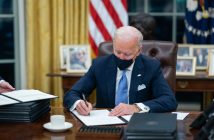It seemed for a moment that after nearly 90 days in office that President Joe Biden and his administration were ready to acknowledge the situation on the southern border was a crisis. In response to a question about delays in raising the cap on refugees admitted into the U.S. annually, President Biden laid blame on the “crisis that ended up on the border with young people.”
“The problem was that the refugee part was working on the crisis that ended up on the border with young people. We couldn’t do two things at once. But now we are going to increase the number,” said Biden on April 17 as he traveled to play golf.
Asked if Biden’s use of crisis was now the official White House position, White House Press Secretary Jen Psaki first avoided answering by noting the administration had moved nearly 1,000 unaccompanied minors from Customs and Border Protection (CBP) facilities and into the care of Health and Human Services since Biden made his remarks.
“The President does not feel that children coming to our border, seeking refuge from violence, economic hardships, and other dire circumstances is a crisis,” Psaki added during her April 19 press briefing.
The absurdity of Psaki’s walking back of Biden’s truthful comments did not go unnoticed by Senate Minority Leader Mitch McConnell.
“The most strength that this administration has shown on the border has been their commitment to their talking points — their refusal to call the crisis a crisis,” said the Kentucky Republican, who asserted the administration writ large was engaged in “woke proofreading.”
McConnell’s criticism is not mere political griping. The fact that administration officials expend more energy avoiding using a single (and apt) word than to solving the humanitarian and national security catastrophe at the border is an important matter. In addition, the downplaying of the border crisis is a direct contrast to other issues. Biden-Harris officials rightly characterize the pandemic and the weak economy as crises. But they also paste the crisis label on problems, such as climate crisis, policing, and racial inequality.
The administration’s aversion to the use of the word crisis to describe the crisis the president’s policies created, stretches back to the onset of his presidency. Asked directly in a February 24 briefing if the surge of migrants to the southern border were a crisis, Psaki refused outright to “label” it as such.
“I don’t think I’m going to put new labels on it from here or from the podium, but it is a priority of the administration, it’s a priority of our Secretary of Homeland Security, and certainly of the President, who’s kept abreast of the developments,” she replied in a preview of what was to come.
On March 1, Department of Homeland Security (DHS) Secretary Alejandro Mayorkas was asked by reporters whether he believed there was a crisis at the border. “I think that the — the answer is no. I think there is a challenge at the border that we are managing,” he responded at a time when more than 200 unaccompanied minors were being apprehended each day. Less than a week later, Mayorkas released a 2,000-plus word statement on the “situation” at the border, but not once was the word crisis used.
In the March 10 daily briefing, newly-appointed border czar and former ambassador to Mexico Roberta Jacobson was asked why there was a reticence to call it a crisis.
“I’m not trying to be cute here, but I think the fact of the matter is: We have to do what we do regardless of what anybody calls the situation,” she said, adding that “whatever you call it wouldn’t change what we’re doing” as it relates to handling the migrant surge.
Even two months of increasing daily apprehension numbers could not move Psaki from her appointed talking points. “Children presenting at our border, who are fleeing violence, who are fleeing prosecution, who are fleeing terrible situations, is not a crisis,” Psaki said. “We feel that it is our responsibility to humanely approach this circumstance and make sure they are treated and put in conditions that are safe,” she claimed on March 22.
But all three administration spokespeople know what a crisis looks like from experience. Jacobson was Assistant Secretary of State for Western Hemisphere Affairs in the Obama-Biden administration, while Psaki served at both the State Department and Obama White House in their respective press offices. Mayorkas had an even closer eye on the 2014 migrant crisis as deputy DHS secretary. The Biden border crisis already has eclipsed the 2014 and 2019 crises – a fact which everyone avoiding the term crisis is well aware.
The wordplay shows the administration’s focus on appearance and optics while ignoring the root problem of illegal immigration. The longer the border crisis is ignored – and that is what the administration is doing – the odds increase that it will worsen. We have seen over the last 90-plus days just how true that is.
To join FAIR’s campaign to send a message to President Biden, Vice President Harris and Congress, click here.
To make a critical donation to FAIR’s efforts to stop the Biden administration’s disastrous dismantling efforts, click here.





1 Comment
Pingback: See No Border Crisis, Hear No Border Crisis, (And Definitely) Speak No Border Crisis | 198 Immigration News